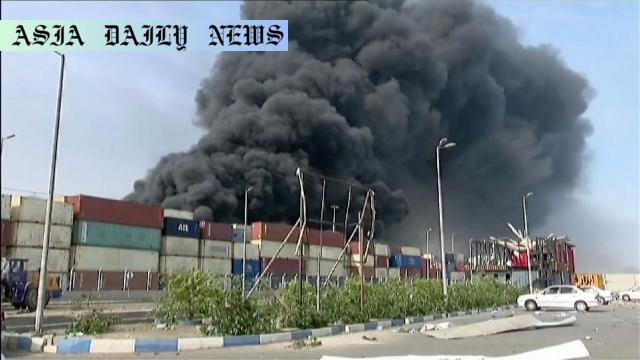Explosion: At least 14 killed and over 700 injured in Bandar Abbas port explosion linked to chemical containers.
A massive explosion in Bandar Abbas port has left at least 14 dead and injured over 700 people.
Iranian authorities have linked the blast to chemical containers stored at the site.
Strong winds continue to hinder firefighters in containing the fires caused by the explosion.
President Masoud Pezeshkian has called for an investigation into the incident’s causes.
Buildings surrounding the site sustained significant damage, with many collapsing.

A Tragic Explosion in Bandar Abbas Port
The recent tragedy in Bandar Abbas, a port city in southern Iran, has left the nation grappling with shock and profound loss. On Saturday, a massive explosion ripped through the port area, claiming the lives of at least 14 individuals and injuring over 700 people. The cause of this devastating event has been linked to containers holding chemical materials, although full clarity on the root of the issue remains elusive as fires continue to rage at the site.
Impact and Immediate Responses
The explosion has wreaked havoc on the surrounding community, causing severe damage to neighboring buildings, many of which have collapsed under the sheer force of the blast. Interior Minister Eskandar Momeni provided updates through Iran’s state-run television, reporting the escalating death toll and noting the overwhelming number of injured citizens, many of whom may face long recoveries. Firefighters are persistently working to contain the fires ignited by the explosion; however, fierce winds are exacerbating the situation and complicating their efforts.
Government’s Reaction and Promised Investigation
President Masoud Pezeshkian expressed his condolences to the victims and their families, emphasizing the gravity of the tragedy. He has directed government officials and investigators to launch a thorough probe into the causes of the explosion. While the government has not released a definitive statement on the underlying factors, initial assessments suggest that improper handling or storage of chemical containers could have contributed to the catastrophic event.
Firefighting Challenges and Community Impact
The fires triggered by the explosion continue to rage, posing challenges for rescue and recovery efforts. Strong gusts of wind fan the flames, raising concerns about further damage and danger to nearby areas. Residents of Bandar Abbas have been deeply affected, as many homes and businesses remain in ruins. The explosion has also drawn attention to broader issues such as safety standards within industrial and port facilities, sparking calls for reforms and stricter policies to prevent similar tragedies in the future.
Long-Term Ramifications
While the immediate priority remains containing the fires and aiding those affected, this incident is likely to have lasting repercussions on Iran’s industrial operations and public trust in safety protocols. Investigators and regulatory bodies will need to reevaluate policies concerning the storage and transportation of hazardous materials. Additionally, the disaster underscores the vulnerabilities of highly congested industrial ports and the dire consequences of accidents occurring in such areas.
The tragedy in Bandar Abbas highlights the urgent need for both short-term humanitarian responses and long-term structural reforms. It serves as a grave reminder of the importance of prioritizing safety and vigilance within all industrial sectors to prevent similar occurrences in the future.



Commentary
The Importance of Proactive Safety Measures
The explosion in Bandar Abbas serves as a harrowing reminder of the significant risks posed by improper storage and handling of hazardous materials. While accidents can happen in even the best-regulated environments, this incident underscores the importance of implementing proactive measures to mitigate potential dangers. Governments and businesses alike have a responsibility to ensure that such materials are managed with precision and care, especially in high-risk areas like industrial ports.
Learning from Tragedy to Prevent Future Incidents
In examining the tragedy at Bandar Abbas, it is evident that systemic changes are necessary to prevent similar disasters. One potential avenue involves stricter enforcement of safety protocols, with regular inspections to ensure compliance. These measures could help identify risks before they escalate into full-blown crises. Moreover, enhanced training programs for personnel working with chemical and explosive materials could play a pivotal role in mitigating risks.
The Human Element of Industrial Disasters
Beyond the statistics, it is essential to remember the human toll of tragedies like the Bandar Abbas explosion. Families have lost loved ones, countless individuals are grappling with physical and emotional scars, and entire communities face the daunting task of rebuilding their lives. As such, any response to this disaster must include significant support for those affected, ranging from medical care to financial assistance and psychological counseling.
A Call for Global Collaboration on Safety Standards
This incident also raises broader questions about global industrial safety standards. While Bandar Abbas may be geographically distant to some, the ripple effects of such disasters are far-reaching. By fostering international collaboration and sharing best practices, countries can work together to enhance safety protocols and prevent catastrophic events worldwide. Every life lost to such tragedies is one too many, and the only way to honor these losses is by ensuring that such occurrences are never repeated.